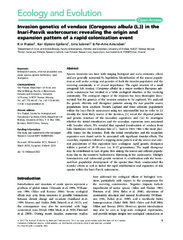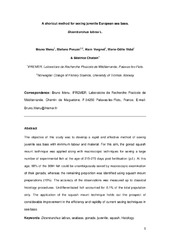Artikler, rapporter og annet (arktisk og marin biologi): Nye registreringer
Viser treff 1521-1540 av 1643
-
Invasion genetics of vendace (Coregonus albula (L.)) in the Inari-Pasvik watercourse: revealing the origin and expansion pattern of a rapid colonization event
(Journal article; Tidsskriftartikkel; Peer reviewed, 2013)Species invasions can have wide-ranging biological and socio-economic effects and are generally unwanted by legislation. Identification of the source population as well as the ecology and genetics of both the invader population and the receiving community is of crucial importance. The rapid invasion of a small coregonid fish vendace (Coregonus albula) in a major northern European subarctic watercourse ... -
A shortcut method for sexing juvenile European sea bass, Dicentrarchus labrax L.
(Journal article; Tidsskriftartikkel; Peer reviewed, 2005)The objective of this study was to develop a rapid and effective method of sexing juvenile sea bass with minimum labour and material.To this end, the gonad squash mount technique was applied along with macroscopic techniques for sexing a large number of experimental fish at the age of 215-275 days post fertilization (p.f.). At this age, 90% of the 3894 fish could be unambiguously sexed by ... -
Genetic investigation of swimbladder inflation anomalies in the European sea bass, Dicentrarchus labrax L.
(Journal article; Tidsskriftartikkel; Peer reviewed, 2007)Although the aetiology of swimbladder inflation anomalies in important aquaculture species such as European sea bass D. labrax is not fully determined, culture conditions are commonly suggested as main contributory factors. Little information is available on whether swimbladder inflation has a genetic basis for its expression too. In this work, 24 full-sibling sea bass families from a 4 dams x 6 ... -
Haematological and physiological characteristics of diploid and triploid sea bass, Dicentrarchus labrax L.
(Journal article; Tidsskriftartikkel; Peer reviewed, 2005)The purpose of this study was to determine whether diploid and triploid sea bass differed in terms of main haematological and physiological characteristics. Diploid and triploid fish were produced by sub-optimal pressure treatments and held in communal environments under standard rearing conditions. Total red blood cell count (RBCC), haemoglobin concentration (Hb), hematocrit (Hct), mean cell volume ... -
Body shape variation in meiotic gynogenetic and triploid sea bass, Dicentrarchus labrax
(Journal article; Tidsskriftartikkel; Peer reviewed, 2010)A method of geometric morphometrics was used to characterize body shape variation in meiotic gynogenetic and triploid sea bass in comparison with diploid controls. A total of 13 coordinate landmark data were recorded on the profile of 34-month-old control (n = 81), gynogenetic (n = 117) and triploid (n = 131) siblings generated from two females (A and B). Three main axes of morphometric variation ... -
Induction of tetraploid gynogenesis in the European sea bass, Dicentrarchus labrax L.
(Journal article; Tidsskriftartikkel; Peer reviewed, 2003)A preliminary study on tetraploid gynogenetic induction in the European sea bass was performed by pressure-blocking the second polar body release and the first cleavage in eggs fertilized with ultraviolet-irradiated sperm. Fertilization of eggs with genetically inactivated sperm produced only haploid development that terminated around hatching. Pressure treatments (8.500 psi for 2 min) applied at 6 ... -
Settling-depth vs. genotype and size vs. genotype correlations at the Pan I locus in 0-group Atlantic cod Gadus morhua
(Journal article; Tidsskriftartikkel; Peer reviewed, 2012)We sampled 0-group juvenile Atlantic cod Gadus morhua L. within fjords and offshore in northern Norway from 1994 to 2008 using different gears for the 3 sampling depths: shore seine (0−3 m), pelagic trawl (various depths), and bottom trawl (>80 m). Frequencies of alleles at the Pan I locus (4218 fish analysed) showed highly significant differences among samples collected in the different habitats. ... -
Organic carbon transformations in high-Arctic peat soils: key functions and microorganisms
(Journal article; Tidsskriftartikkel; Peer reviewed, 2012)A substantial part of the Earths’ soil organic carbon (SOC) is stored in Arctic permafrost peatlands, which represent large potential sources for increased emissions of the greenhouse gases CH4 and CO2 in a warming climate. The microbial communities and their genetic repertoire involved in the breakdown and mineralisation of SOC in these soils are, however, poorly understood. In this study, we applied ... -
Export stoichiometry and contribution of copepod faecal pellets to vertical flux of particulate organic carbon, nitrogen and phosphorus
(Journal article; Tidsskriftartikkel; Peer reviewed, 2012)Sinking of particles is a key mechanism in the transport of organic matter from the ocean’s productive surface layer to the deep sea and sediments, but also constitutes a loss of carbon and growth-limiting nutrients to the pelagic food web. Knowledge on export of particulate phosphorus is limited, particularly in high-latitude regions, in spite of its role as a co-limiting factor in many marine ... -
Invasive red king crab affects lumpsucker recruitment by egg consumption
(Journal article; Tidsskriftartikkel; Peer reviewed, 2012)The invasive red king crab Paralithodes camtschaticus preys on lumpsucker Cyclopterus lumpus eggs. We tested the hypothesis this egg consumption may hamper the recruitment of lumpsucker. Methods applied included field work, laboratory experiments and modelling of egg consumption. Crabs were sampled and feeding behaviour was studied by means of a remotely operated vehicle and SCUBA divers in a field ... -
Plastid located WHIRLY1 enhances the responsiveness of Arabidopsis seedlings toward abscisic acid
(Journal article; Tidsskriftartikkel; Peer reviewed, 2012)WHIRLY1 is a protein that can be translocated from the plastids to the nucleus, making it an ideal candidate for communicating information between these two compartments. Mutants of Arabidopsis thaliana lacking WHIRLY1 (why1) were shown to have a reduced sensitivity toward salicylic acid (SA) and abscisic acid (ABA) during germination. Germination assays in the presence of abamine, an inhibitor of ... -
Dual Targeting and Retrograde Translocation: Regulators of Plant Nuclear Gene Expression Can Be Sequestered by Plastids
(Journal article; Tidsskriftartikkel; Peer reviewed, 2012)Changes in the developmental or metabolic state of plastids can trigger profound changes in the transcript profiles of nuclear genes. Many nuclear transcription factors were shown to be controlled by signals generated in the organelles. In addition to the many different compounds for which an involvement in retrograde signaling is discussed, accumulating evidence suggests a role for proteins in ... -
Protein genes in repetitive sequence—antifreeze glycoproteins in Atlantic cod genome
(Journal article; Tidsskriftartikkel; Peer reviewed, 2012)Highly repetitive sequences are the bane of genome sequence assembly, and the short read lengths produced by current next generation sequencing technologies further exacerbates this obstacle. An adopted practice is to exclude repetitive sequences in genome data assembly, as the majority of repeats lack protein-coding genes. However, this could result in the exclusion of important genotypes in newly ... -
Spring bloom dynamics in Kongsfjorden, Svalbard: nutrients, phytoplankton, protozoans and primary production
(Journal article; Tidsskriftartikkel; Peer reviewed, 2012)The marine ecosystem in Kongsfjorden (79 N), a glacial fjord in Svalbard, is to a large extent well known with regard to hydrography, mesozooplankton and higher trophic levels. Research on primary production and lower trophic levels is still scare and especially investigations from winter and spring periods. The spring bloom dynamics in Kongsfjordenwere investigated in 2002. The development in ... -
Potential misidentifications of two climate indicator species of the marine arctic ecosystem: Calanus glacialis and C. finmarchicus
(Journal article; Tidsskriftartikkel; Peer reviewed, 2012)Calanoid copepods of the genus Calanus represent an important, nutrient-rich food source for a multitude of Arctic marine organisms. Although morphologically very similar, their life histories and ecological roles differ. Because the distribution of Calanus glacialis and C. finmarchicus corresponds to Arctic and Atlantic water masses, respectively, they are regularly used as climate indicators. A ... -
Age-dependent genetic structure of arctic foxes in Svalbard
(Journal article; Tidsskriftartikkel; Peer reviewed, 2012) -
Evolution of the Arctic Calanus complex: an Arctic marine avocado?
(Journal article; Tidsskriftartikkel; Peer reviewed, 2012)Before man hunted the large baleen whales to near extinction by the end of the nineteenth century, Arctic ecosystems were strongly influenced by these large predators. Their main prey were zooplankton, among which the calanoid copepod species of the genus Calanus, long considered key elements of polar marine ecosystems, are particularly abundant. These herbivorous zooplankters display a range of ... -
Bioluminescence in the high Arctic during the polar night
(Journal article; Tidsskriftartikkel; Peer reviewed, 2012)This study examines the composition and activity of the planktonic community during the polar night in the high Arctic Kongsfjord, Svalbard. Our results are the first published evidence of bioluminescence among zooplankton during the Arctic polar night. The observations were collected by a bathyphotometer detecting bioluminescence, integrated into an autonomous underwater vehicle, to determine the ... -
New parasites and predators follow the introduction of two fish species to a subarctic lake: implications for food-web structure and functioning
(Journal article; Tidsskriftartikkel; Peer reviewed, 2012)Introduced species can alter the topology of food webs. For instance, an introduction can aid the arrival of free-living consumers using the new species as a resource, while new parasites may also arrive with the introduced species. Food-web responses to species additions can thus be far more complex than anticipated. In a subarctic pelagic food web with free-living and parasitic species, two fish ... -
Bird communities of the Arctic shrub tundra of Yamal: habitat specialists and generalists
(Journal article; Tidsskriftartikkel; Peer reviewed, 2012)The ratio of habitat generalists to specialists in birds has been suggested as a good indicator of ecosystem changes due to e.g. climate change and other anthropogenic perturbations. Most studies focusing on this functional component of biodiversity originate, however, from temperate regions. The Eurasian Arctic tundra is currently experiencing an unprecedented combination of climate change, change ...


 English
English norsk
norsk


















